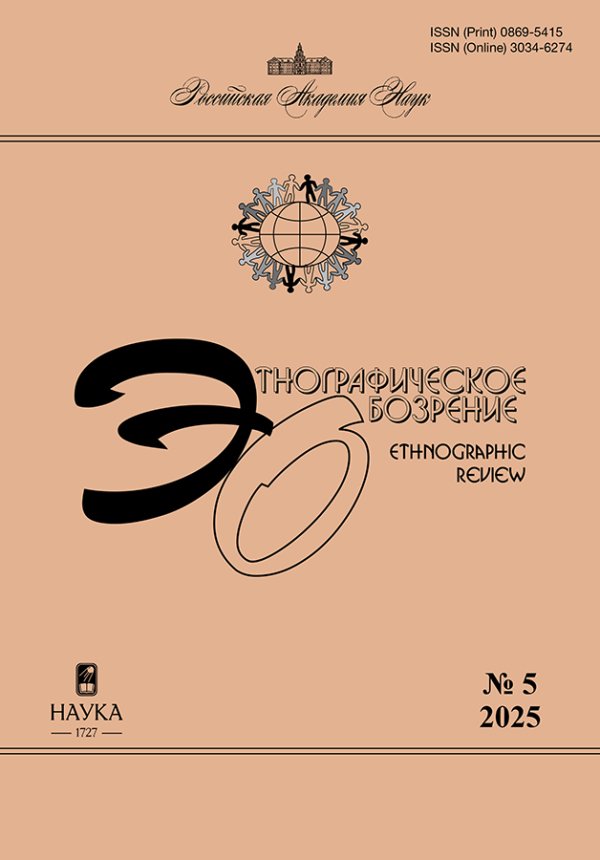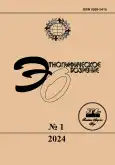№ 1 (2024)
Дискуссия
Тайна геродотовских саспиров
Аннотация
В статье анализируются доисторические факты о геродотовских саспирах в контексте кавказской истории сапиров/савиров. Автор рассматривает как первоисточники, так и публикации ведущих исследователей по теме. В целях получения системной картины вводятся данные по этнониму, истории, географии, религии, этнографии и языку. В частности, делается вывод, что между этнонимами Σάσπειρες, Σάπειρες, Σάβιροι, Sapires, Savares, Savirs имеется историческая преемственность. В изучаемый период саспиры обитали на землях от Мидии до Колхиды между мидянами и колхами (мидяне находились к югу, а колхи к северу от р. Фасис) к юго-востоку от р. Чорох в сторону озер Севан и Ван. Матиенскими горами, возле которых жили саспиры, считаются горы в районе Эрзурума.
 5-22
5-22


Обсуждая вопрос о геродотовских саспирах
Аннотация
Авторы обсуждают положения статьи А.К. Салмина “Тайна геродотовских саспиров”, в которой на основе анализа первоисточников и научных публикаций рассматриваются доисторические факты о геродотовских саспирах в контексте кавказской истории сапиров/савиров. В целях получения системной картины А.К. Салминым вводятся данные по этнониму, истории, географии, религии, этнографии и языку. В частности, делается вывод, что между этнонимами Σάσπειρες, Σάπειρες, Σάβιροι, Sapires, Savares, Saviri имеется историческая преемственность. Аргументацию данных положений обсуждает коллектив участников в комментариях, включающих “Саспиритида и чуваши: поиски связей” (Д.Ф. Мадуров), “Что общего может быть между далекими предками чувашей и древними армянами?” (А.К. Шагинян), “Неосведомленность или научная недобросовестность?” (О.Г. Хорикян), «“Тайна” саспиров раскрыта?» (А.С. Сараев).
 23-59
23-59


Возвращаясь к напечатанному
От “вернакулярных” музеев к “прошлому своими руками”
Аннотация
Статья посвящена понятию “вернакулярные музеи”, предложенному Ириной Слепцовой (Кызласовой) и Еленой Чесноковой в одном из номеров журнала “Этнографическое обозрение”. Откликаясь на идею авторов, я продолжаю начатую ими линию рассуждения, расширяя контекст анализа этого явления. В статье рассматриваются проблемы, затрудняющие использование термина “вернакулярный музей”, включая наличие предшественников таких музеев, противоречия, заложенные в систему типологизации музейного разнообразия, обусловленные ее использованием как в области практики, так и в области анализа, а также проблемы, связанные с концептуализацией вернакуляров как значимого Другого относительно официально признанных образцов музеестроительства. В статье предлагается альтернативный ракурс анализа современных форм музейных инициатив, позволяющий включить их в один ряд с типологически близкими формами низовых коммемораций и мемориального активизма.
 60-76
60-76


Народное христианство Армении
Проживаемая религия почитателей сельских сурбов в Армении
Аннотация
В статье на основе подходов проживаемой религии (lived religion) анализируются представления и практики почитателей сельских сурбов в Армении. Сурб означает “святой”, “священный”, “божественный”, это святой и место почитания. Сурбом может быть книга, хачкар, церковь, дерево, изображение и т.д. – любой объект, считающийся святым. Для повседневной религии почитателей сельских сурбов характерны особые взаимоотношения верующих со священным и божественной силой святых. Люди воспринимают силу сурба как реальную и эффективную и испытывают на себе ее влияние каждый день. Ритуальные практики в святилищах рассматриваются как способ воздействия на божественную силу для удовлетворения определенных потребностей и выполнения некоторых задач. Верующим также важен физический контакт со святыней. Представления и практики почитателей сельских святынь не одобряются Армянской апостольской церковью. В Армении наряду с официальной канонической существует вернакулярная устная религиозная традиция.
 77-92
77-92


Сон и святыня в армянском народном христианстве: предварительные результаты исследований
Аннотация
Этнографическое, с применением феноменологического подхода исследование снов при сравнении опубликованного материала с полевым выявляет закономерности, связанные с многовековой традицией. Отношение к снам как к информации о будущих событиях в наше время присуще религиозным, но редко посещающим церковь людям. Сновидения о святилищах традиционно классифицируются как истинные, и их указания неукоснительно выполняются. Посредством снов осуществляется общение между сновидцем и персонифицированным святилищем, предписывающим раскапывать определенные места, не прикасаться к священному объекту, совершать паломничества, переносить объект почитания в новое место и т.п. Некоторые сны способствуют нахождению исторических памятников. В Армении есть особые святилища, избавляющие от последствий плохих, часто связанных с образом Тух Манука сновидений. В особых святилищах производится инкубация с целью излечения. Сны в святилище и после его посещения считаются священными и часто свидетельствуют об избавлении от болезни.
 93-114
93-114


Статьи и материалы
Дамы с собачками: отношение к собакам в России в XVIII–XIX вв.
Аннотация
В статье исследуется отношение представителей знатного сословия Российской империи к собакам. Источниками служат главным образом мемуары, а также произведения русской литературы XVIII–XIX вв., особенно такие, в которых “собачья” тема не является главной, а вводится попутно, в качестве дополнительной характеристики обстановки или героя. Выясняется, что у женщин и мужчин отношение к собакам было различным. Кроме того, мужчины и женщины предпочитали общаться с разными породами. В российском обществе XVIII–XIX вв. комнатные (дамские, постельные) собачки являлись атрибутом богатой и знатной дамы. Мужчины относились к таким породам с пренебрежением. Тщедушная, прихотливая, несамостоятельная любимица хозяйки вполне соответствовала тогдашней манере поведения барышни и дамы – с ее нарядами, обмороками, зависимостью от мужчины. С другой стороны, мужчины были покровительственно привязаны к своим охотничьим (иногда и сторожевым) псам – крупным, сильным, задиристым, которые обычно обитали не в доме, а на дворе. Постепенно мода на комнатных собачек стала проходить, и любимыми домашними питомцами становились кошки. С середины XIX в. в окружении своих мосек, левреток, шпицев, болонок чаще можно было заметить пожилую барыню.
 115-132
115-132


Антропологическая фотография 1920-х – начала 1930-х годов в контексте освоения советской властью национальных территорий
Аннотация
Статья посвящена различным аспектам создания антропологической фотографии в 1920-е – начале 1930-х годов. На примере истории развития визуального документа представлены проблемы научного освоения национальных окраин. Особенности формирования комплекса фотоизображений периода национального строительства рассмотрены в контексте выбора территорий и этносов для изучения, взаимодействия с властными структурами и подхода к работе с местным населением. В тексте показаны различные ситуации, в которых создавались антропологические фотодокументы, и проанализированы отчеты, отражавшие научные задачи ученых. На примере истории формирования фотофонда МАЭ РАН представлены основные этапы и направления исследований, технические особенности производства фотодокумента и архивации его в музейном собрании. Поднимаются вопросы авторской методики фотофиксации изображений, проблемы этики взаимодействия с субъектами и публикации материалов научных экспедиций.
 133-150
133-150


Евреи Дона в XIX – начале XXI в.: геодемографическая динамика и воспроизводственные процессы региональной общины
Аннотация
В статье анализируются воспроизводственные, миграционные процессы, количественная, пространственная, половозрастная динамика еврейского населения Донского края. Зафиксированы основные этапы геодемографической эволюции донских евреев в XIX – начале XXI в., изучены особенности системы их расселения, гендерной структуры в городах и сельской местности. Установлено, что уже в начале ХХ в. высокий уровень урбанизации и социокультурной модернизации активизирует процесс ассимиляции евреев Дона. Демографические потери в годы Великой Отечественной войны предопределили ускоренное сокращение общины в послевоенный период, еще более усилив ассимиляционные тенденции. Среди последствий нарастающей с 1920–1930-х годов ассимиляции отмечаются абсолютный рост и удельное расширение региональной группы смешанного населения с еврейскими корнями, не фиксируемого официальной статистикой. Для отдельных этапов геодемографической эволюции ХХ – начала XXI в. выполнена оценка этой латентной компоненты. Установлено, что к концу ХХ в. она многократно превосходила размеры этнического ядра областной общины, а в последние 20–30 лет становится все более значимым фактором демографического воспроизводства и социокультурной жизнедеятельности еврейского населения Дона.
 151-179
151-179


Влияние центральноазиатской миграции на исламское пространство уральского города (на примере Челябинска, Магнитогорска и Троицка)
Аннотация
Статья посвящена влиянию центральноазиатской миграции на исламское пространство городов Урала на примере Челябинска, Магнитогорска и Троицка. Источниковую базу составили материалы интервью и включенного наблюдения. Применение концепта о праве на город в качестве теоретико-методологической рамки позволяет описать отношения, которые складываются вокруг символической власти над городским пространством. В данном случае речь идет об объектах социальной инфраструктуры, созданных мигрантами или используемых ими в повседневной жизни для удовлетворения религиозных потребностей (мечети, молитвенные дома, кафе халяльной кухни, лавки исламской моды). Мигранты-мусульмане приобретают опыт организационной деятельности и накапливают различные ресурсы для формирования и развития религиозной инфраструктуры, что позволяет удовлетворять социальные и духовные потребности различных мигрантских групп.
 180-196
180-196


Отцовская забота в современном обществе (сравнение России и Беларуси)
Аннотация
Отцовская забота способствует интеллектуальному развитию детей и благотворно влияет на их успешность во взрослой жизни. Существенное воздействие на отцовскую заботу оказывают культурные стереотипы и индивидуальные представления о распределении семейных ролей. В статье представлены результаты кросс-культурного исследования отцовской заботы в России и Беларуси, проанализировано совокупное влияние на заботу уровня достатка в семье и индивидуальных представлений о гендерном неравенстве. Общая выборка составила 570 человек. Результаты исследования выявили сходство поведенческих моделей отцов в России и Беларуси. Общая модель отцовской заботы показала, что высокий уровень достатка способствует росту отцовской заботы в обеих странах, тогда как высокий уровень гендерного неравенства снижает уровень заботы отца. Наши данные показали, что Россия и Беларусь продолжают практиковать традиционный подход к разделению забот в отношении детей – женщины чаще занимаются воспитанием и образованием, тогда как мужчины больше вкладывают в финансовую составляющую семьи.
 197-225
197-225


Критика, обзоры, рецензии
Этнографическое отражение в региональных исследованиях: проявление “большого” в “малом” (рец. на: Рыжакова С.И. Северная Бенгалия: этнический профиль и этнографическая картина восточно-пригималайских областей Индии. М.; Спб.: Нестор-История, 2022. 408 с., ил.)
 226-229
226-229


Вотивы и вотивные практики – взгляд на феномен (рец. на: Майзульс М., Зотов С., Антонов Д. Восковые ноги и железные глаза. Вотивные практики со Средневековья до наших дней. М.: Слово, 2022. 368 с.)
 230-234
230-234


Советский отпуск – это маленькое путешествие в коммунизм (медсправка обязательна!) (рец. на: Коенкер Д. SPAсибо партии. Отдых, путешествия и советская мечта. СПб.: Библиороссика, 2022. 455 с.)
 235-242
235-242












